Hammock


A hammock is a sling made of fabric, rope, or netting, suspended between two points, used for swinging, sleeping, or resting. It normally consists of one or more cloth panels, or a woven network of twine or thin rope stretched with ropes between two firm anchor points such as trees or posts. Hammocks were developed by native inhabitants of Central and South America for sleeping. Later, they were used aboard ships by sailors to enable comfort and maximize available space, and by explorers or soldiers travelling in wooded regions and eventually by parents in the 1920s for containing babies just learning to crawl. Today they are popular around the world for relaxation; they are also used as a lightweight bed on camping trips. The hammock is often seen as a symbol of summer, leisure, relaxation and simple, easy living.
History
European first contact
Spanish colonists noted the use of the hammock by Native Americans, particularly in the West Indies, at the time of the Spanish conquest.[1] The word comes from a Taíno culture Arawakan word (Haiti) meaning "fish net".[2][3]
_(c112-01-24).jpg)
Early hammocks were woven out of bark from a hamack tree, and later this material was replaced by sisal fibers because it was more abundant. One of the reasons that hammocks became popular in Central and South America was their ability to provide safety from disease transmission, insect stings, or animal bites. By suspending their beds above ground, inhabitants were better protected from snakes, biting ants, and other harmful creatures.[4] Hammocks were introduced to Europe by Christopher Columbus when he brought several of them back to Spain from islands in the present day Bahamas.
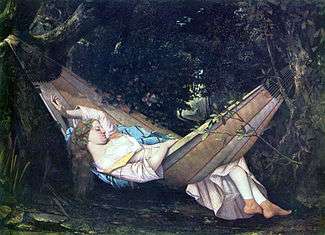
Gustave Courbet (1819–1877)
The origin of the hammock in the Americas is often obscured in English-language sources from the late 18th century onward. Samuel Johnson claimed that the word hammock was of Saxon origin.[5] This etymology was soon debunked,[6] and later 19th-century sources attributed the invention to the Athenian politician Alcibiades.[7] This was inferred from Plutarch, who wrote that Alcibiades had his galley bed hung from ropes, but did not specifically describe it as a net or sling.[8] A few European sources mention the historical use of cloth slings as carriage seats, but not as regular beds.[7]

Naval hammocks
Around 1590, hammocks were adopted for use in sailing ships; the Royal Navy formally adopted the canvas sling hammock in 1597. Aboard ship, hammocks were regularly employed for sailors sleeping on the gun decks of warships, where limited space prevented the installation of permanent bunks. Since a slung hammock moves in concert with the motion of the vessel, the occupant is not at a risk of being thrown onto the deck (which may be 5 or 6 feet below) during swells or rough seas. Likewise, a hammock provides more comfortable sleep than a bunk or a berth while at sea since the sleeper always stays well balanced, irrespective of the motion of the vessel. Prior to the adoption of naval hammocks, sailors would often be injured or even killed as they fell off their berths or rolled on the decks on heavy seas. The sides of traditional canvas naval hammocks wrap around the sleeper like a cocoon, making an inadvertent fall virtually impossible. Many sailors in the Royal Navy, during the 1950s at least, used a spreader - a length of wood with a V cut in each end to engage the second hammock string on each side. The first string was set up more tightly than the others so that it raised a protective lip along each side to keep out drafts and prevent the sleeper being thrown out. A narrow mattress was also issued which protected the user from cold from below. In addition naval hammocks could be rolled tightly and stowed in an out of the way place or in nets along the gunwale as additional protection during battle (as was the case during the age of sail). Many sailors became so accustomed to this way of sleeping that they brought their hammocks ashore with them on leave. The naval use of hammocks continued into the 20th century. During World War II, troopships sometimes employed hammocks for both naval ratings and soldiers in order to increase available space and troop carrying capacity. Many leisure sailors even today prefer hammocks over bunks because of better comfort in sleep while on the high seas.
Hammocks have also been employed on spacecraft in order to utilize available space when not sleeping or resting. During the Apollo program, the Lunar Module was equipped with hammocks for the commander and lunar module pilot to sleep in between moonwalks.
El Salvador hammocks

El Salvador is a hammock cultured country, and a large producer and exporter of hammocks. The valley in which San Salvador City sits upon is dubbed "The Valley of the Hammocks" because the Native Americans, used hammocks to repel constant earthquakes. Later, the colonizing Spaniards used the term as an allusion of earthquakes constantly rocking the valley where San Salvador City is, like a hammock. Hammocks are a big part of Salvadoran culture and are often used for afternoon naps. Hammocks swing from doorways, inside living rooms, on porches, in outdoor courtyards, and from trees. Just about everywhere a hammock can be seen hung in all social classes of Salvadoran homes. It is completely socially acceptable to lay around in a hammock all day in this Central American country, that hammocks can be seen from the most humble rual home, to the most prestigious city hotel chains, where there are the colorful and comfortable hammocks. To honor such a pleasure craft, the municipality of "Concepcion Quezaltepeque" celebrates its traditional Hammocks Festival, where artisans produce and sell hammocks as a tradition that is celebrated every year, between the first and second weekend of November, it is “The Festival of the Hammocks”. Hammocks are sold in every corner in towns and cities.
Mexican and Mayan hammocks
In Mexico, hammocks are made in villages surrounding the capital city of the Yucatán, Mérida, and are sold throughout the world as well as locally. They were not part of Classic era Maya civilization; they were said to have arrived in the Yucatán from the Caribbean fewer than two centuries before the Spanish conquest. In addition to bark and sisal, hammocks were constructed from various materials, including palm fronds in western Amazonia. Quality of native and modern hammocks depends greatly on the quality of the material, thread, and the number of threads used. Mayan hammocks are made on a loom and are hand woven by men, women and children. Hammocks are so symbolically and culturally important for the Yucatecans that even the most humble of homes have hammock hooks in the walls; in rural El Salvador, a family home may have multiple hammocks strung across the main room, for use as seating, as beds, or as sleep-swings for infants.
Venezuelan hammock
In Venezuela entire villages raised their families in hammocks. During the first part of the 20th century, many scientists, adventurers, geologists and other non-native visitors to Central and South American jungles soon adopted the Venezuelan hammock design, which gave protection against scorpions and venomous snakes such as the fer de lance. The difficult jungle environments of South America encountered by Western explorers soon stimulated further development of the Venezuelan hammock for use in other tropical environments.
The Venezuelan hammock's panels were always made of breathable material, necessary to prevent the onset of fungal infections caused by constant rain and high humidity.[9] Fine-woven sandfly netting was eventually added to provide more complete protection from mosquitoes, flies, and crawling insects, especially in regions notorious for malaria or screwworm infestations. A waterproof top sheet or rainfly could be added to protect the occupant from drenching by heavy nighttime rains, along with drip strings - short pieces of string tied to suspension lines — to prevent rainwater running from the tree trunk down the hammock cords to the hammock itself. A breathable false cotton (later nylon) bottom panel was frequently added to these jungle hammocks, allowing air to pass through while still preventing mosquito stings to the occupant.[9]
Jungle Hammock
The Venezuelan hammock, as modified, eventually became known as a jungle hammock. Simply by wetting the hammock suspension ropes with insecticides or insect repellent, the jungle hammock even gave protection against crawling insects with mandibles that could bite holes through the insect netting.
The United States Army eventually adopted their own version of the jungle hammock, complete with rain proof fly and sandfly netting for use by U.S. and Allied forces in tropical jungle regions such as Burma during World War II.[9] While at first reluctant to accept the idea of its men sleeping in hammocks, the United States Marine Corps later employed jungle hammocks in New Britain[10] and later Pacific island campaigns where heavy rain and insects were prevalent; concerns over injuries from machine gun and artillery fire were overcome by first digging a slit trench, then staking the hammock's support lines to suspend the hammock beneath ground level.[11]
Later U.S. Army hammocks issued during the Vietnam War, such as the M1966 Jungle Hammock, were mistakenly fitted with waterproof bottom panels, which often became filled with water overnight.[12] On the other side, North Vietnamese Army (NVA) and Viet Cong (VC) forces regularly employed jungle hammocks fabricated from scavenged or captured US parachute cloth and shroud lines. Hung well off jungle trails, the hammocks kept down the incidence of disease and illness, which NVA commanders generally regarded as a greater threat than shrapnel injuries caused by sleeping above ground.[13]
Indian hammock
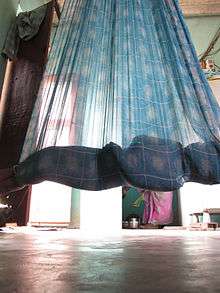
Ceiling mounted hammocks for babies are traditional to south India. The textile used is the woven 5 meter Sari, which is long enough to be hung high, yet reach low enough to be safe for toddlers. The light material allows perspiration and cooling in the hot climate native to this region.
Current
Usage
There are currently a wide variety of hammocks available. There are hammocks that are designed specifically for backpacking and include mosquito netting along with pockets for nighttime storage. There are hammocks made out of thin and lightweight material which makes them ideal for taking on daytrips. Other hammocks include self-standing metal or wood structures that support the hammock. Given that hammocks are commonly similar lengths to accommodate for an average adult's height, most hammock stands are universal in design, typically featuring a spreader bar that runs along the ground, feet for stability at each end, and a diagonal arm at each end to provide two hanging points. Although they are usually bought premade, it is also possible to make your own hammock.
Current Hammocks
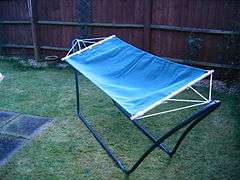 Hammock on a frame in a residential backyard
Hammock on a frame in a residential backyard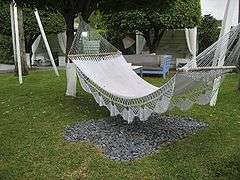 Crocheted hammock
Crocheted hammock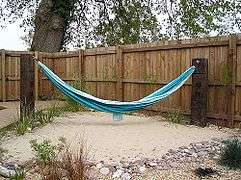 Nylon hammock,
Nylon hammock,
residential backyard.
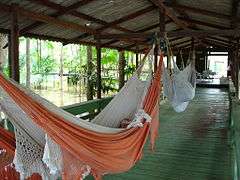 Hammocks,
Hammocks,
Amazon River island,
Brazil.
Hammocks are very popular in the Brazilian northeast region, but not only as sleeping devices: in the poorest areas of the sertão, if there is not a cemetery in a settlement, hammocks may be used to carry the dead to a locale where there is one; also, they frequently serve as a low-cost alternative to coffins. This custom inspired Candido Portinari's 1944 painting Enterro na Rede ("burial in the hammock").[14] Traditionally the sailors who have died at sea were buried at sea in their hammocks.
Medical research suggests the gentle rocking motion of the hammock allows users to fall asleep faster and sleep more deeply compared to a traditional, stationary mattress.[15]
Styles
Current popular hammock styles include the Spreader-bar, Mayan, Brazilian, naval, Nicaraguan, Venezuelan (Jungle), and travel hammocks. Each style is distinctive and has its own set of advantages and disadvantages. Many hammocks come in a variety of colors, patterns, and sizes ranging from a one-person (250 - 350 lbs / 110 – 160 kg) to two or three person (400 lbs - 600 lbs / 180 – 270 kg). Common dimensions for unslung hammocks fall in a range between 3'/0.9m to 14'/4.2m across and 6'/1.8m to 11'/3.3m long.
The spreader-bar hammock is easily recognized by wooden or metal bars at the head and foot of the hammock, spreading its width and allowing for easy access for casual use, such as in a backyard. Unfortunately, the spreader bars also make the hammock unsteady since the metacenter of the hammock when sleeping is very high. This style is generally considered less stable and less comfortable for sleeping than other styles. A subset of this style is the single-spreader bar hammock, which uses a spreader bar on only one end and is much more stable. A variation of the single-spreader bar hammock has three attachment points, one at each corner of the spreader bar and one at the non-spreader bar end and is nearly untippable.
While the various styles of hammocks available today are similar in form, they differ significantly in materials, purpose, and construction.
Mayan and Nicaraguan hammocks are made from either cotton or nylon string that are woven to form a supportive net. Mayan Hammocks have a looser weave than Nicaraguan hammocks, and the supportiveness of the hammock “bed” depends on the number of strings and quality of the weave.
Brazilian hammocks are made from cotton fabric and usually more durable than the string varieties. While Mayan and Nicaraguan hammocks are considered by some to have the potential to be more comfortable, the Brazilian hammock’s comfort is less dependent on its construction and therefore less likely to vary as highly from manufacturer to manufacturer.
Naval hammocks are usually made from canvas or strong cotton. They are intended to be durable and stand well the hardships of the shipboard use. They usually are simple and undecorated but robust.
Venezuelan or Jungle hammocks made today are generally of breathable nylon or polyester, and use dacron or similar non-stretch suspension lines. They are 'inline' hammocks; like the canvas naval hammocks of old, the occupant sleeps along the length of the hammock, rather than across it. With their breathable false bottoms, drip strings, sandfly netting, and optional rainfly, they are one of the most secure hammocks against not only water entry, but also insect stings or bites.

Travel or camping hammocks are popular among Leave No Trace and Ultra Light campers, hikers, and sailing enthusiasts for their reduced impact on the environment and their lightness and lack of bulk compared to tents. They are typically made of sturdy nylon parachute fabric which may use ripstop techniques to improve durability. Some hammocks feature a mosquito net and storage pockets. Some types offer a ridgeline to make set up easier, and may also include a slit for entry through the bottom of the hammock. Special webbing straps (called "treehuggers") are used to loop around trees in order to create attachment points for the hammock.
Set-up and use
For non spreader-bar styles, the way in which they are hung is critical for comfort. Generally, a higher attachment point is preferred as well as sufficient length between points, though these two dimensions can be adjusted to compensate for a lack in one or the other. The optimal angle of the attaching lines to the post / wall / tree is usually about 30 degrees.[16]
Though one can lie in a hammock lengthwise or across its width, most hammocks are best used with a diagonal position, as it provides the most room and support. Users with back and joint pains often report some relief from these problems when sleeping in a hammock in this manner.
Gallery
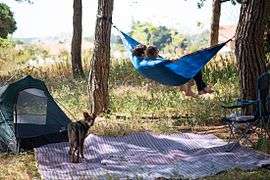 Nylon ripstop
Nylon ripstop
camping hammock Mayan hammock
Mayan hammock.jpg) Hammock aboard the Grand Turk
Hammock aboard the Grand Turk Hammock on a tropical beach
Hammock on a tropical beach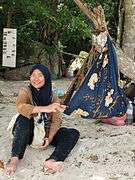 Baby hammock, Pangkor
Baby hammock, Pangkor- Bear in a hammock
Kuangsi sanctuary, Laos
See also
References
| Wikimedia Commons has media related to hammocks. |
| Look up hammock in Wiktionary, the free dictionary. |
- ↑ Bartolomé de las Casas (1542) The Destruction of the Indies
- ↑ Douglas Harper (2001). Hammock - Online Etymology Dictionary. Retrieved December 23, 2006.
- ↑ The several contributors (2001). Manfred Görlach, ed. A Dictionary of European Anglicisms: A Usage Dictionary of Anglicisms in Sixteen European Languages. New York City: Oxford University Press. p. 143. ISBN 0-19-928306-0.
- ↑ Encyclopædia Britannica (1823)
- ↑ Samuel Johnson (1785) A Dictionary of the English Language
- ↑ Arthur Broughton (1797) The History, Civil and Commercial, of the British Colonies in the West Indies
- 1 2 Thomas Dudley Fosbroke (1825) Encyclopædia of Antiquities
- ↑ Plutarch, Life of Alcibiades
- 1 2 3 Kearny, Cresson H. (Major), Jungle Snafus...And Remedies, Oregon Institute (1996), pp. 240-248
- ↑ Leckie, Robert, Helmet For My Pillow, Bantam (1979), pp. 230, 237-238
- ↑ Kearny, Cresson H. (Major), Jungle Snafus...And Remedies, Oregon Institute (1996), pp. 244-254, 261
- ↑ Kearny, Cresson H. (Major), Jungle Snafus...And Remedies, Oregon Institute (1996), pp. 256-257
- ↑ Kearny, Cresson H. (Major), Jungle Snafus...And Remedies, Oregon Institute (1996), pp. 252-253
- ↑ "UOL - O melhor conteúdo". uol.com.br.
- ↑ "Hammocks Help You Sleep". WebMD.
- ↑ Derek Hansen: The ultimate hang, page 14, ISBN 9781466263680